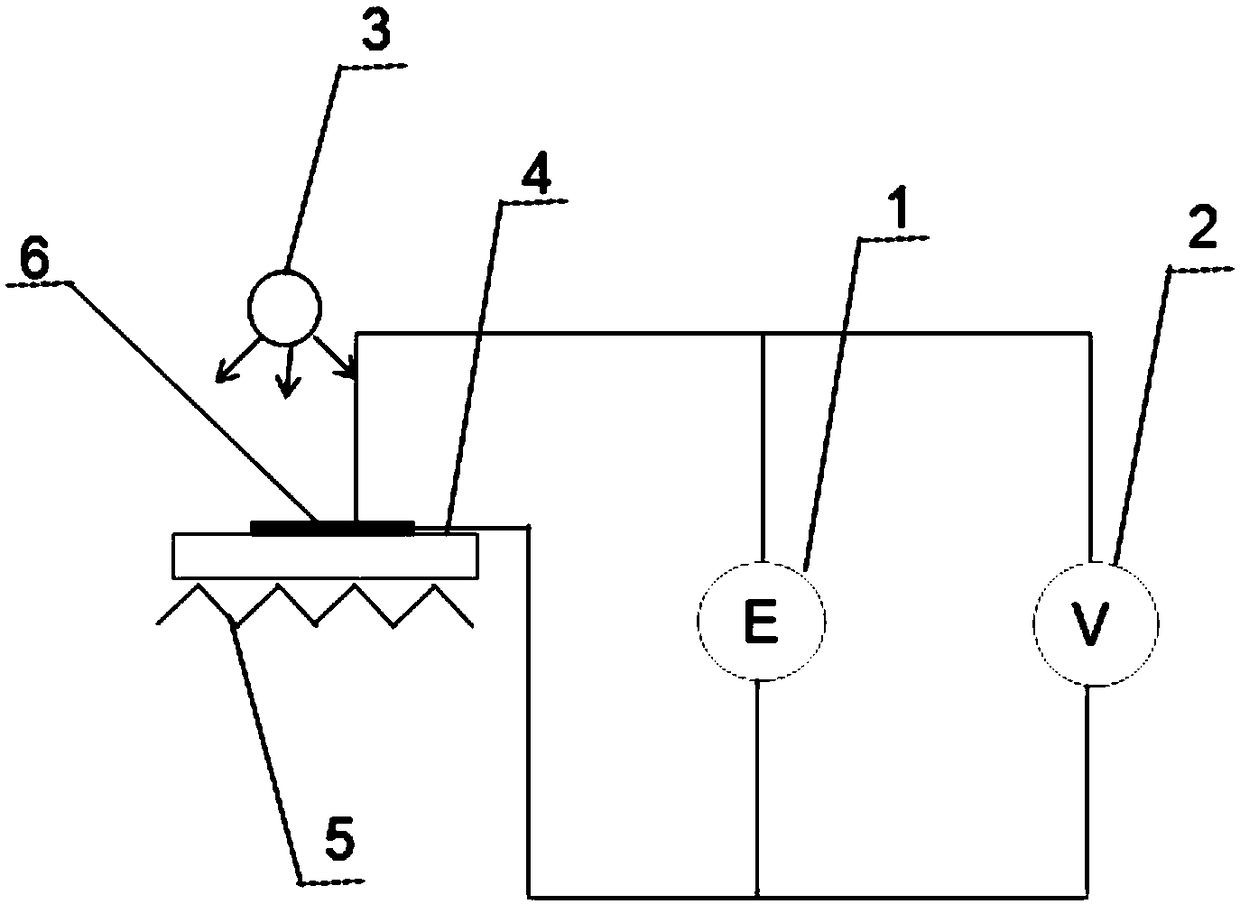Device and method for detecting light-induced degradation (LID) of crystalline silicon cell
A technology of light-induced attenuation and crystalline silicon cells, applied in photovoltaic power generation, photovoltaic modules, electrical components, etc., can solve problems such as inability to monitor the production process in real time, affect production line production, and high risk of battery cells, so as to reduce the risk of unqualified , easy operation, simple steps
- Summary
- Abstract
- Description
- Claims
- Application Information
AI Technical Summary
Problems solved by technology
Method used
Image
Examples
Embodiment 1
[0038] Please refer to figure 1 This embodiment provides a device for detecting light-induced attenuation of a crystalline silicon battery, which includes a placement platform 4, an illumination simulator 3, a heating device 5, a power source 2, and a voltmeter 1.
[0039] The placing platform 4 is used for placing the battery sheet 6. The light simulator 3 is located above the placement platform 4 and is used to perform flash test on the cell 6. The heating device 5 is located below the placing platform 4 and is used to heat the battery sheet 6 on the placing platform 4. The power source 2 is electrically connected to the battery sheet 6 through a wire for inputting current to the battery sheet 6. The voltmeter 1 is electrically connected to the battery sheet 6 through a wire, and is used to detect the voltage of the battery sheet 6.
[0040] The device for detecting light-induced attenuation of a crystalline silicon cell has a simple structure and can quickly detect whether th...
Embodiment 2
[0048] This embodiment provides a method for detecting light-induced attenuation of a crystalline silicon cell, which includes the following steps:
[0049] (1) Place the cell on the cell placement platform, and connect the electrodes on the surface of the cell with the voltmeter with wires;
[0050] (2) Turn on the light simulator to perform flash test on the cell, and record the value V1 of the voltmeter;
[0051] (3) Turn off the light simulator, heat the cell to 350°C and maintain a constant temperature;
[0052] (4) Connect the electrodes on the surface of the battery to the power supply with wires, and pass current to the battery, the current is 5A, and the pass-in time is 1min;
[0053] (5) Stop heating and stop passing current, cool the battery to room temperature, connect the surface electrode of the battery to the voltmeter with a wire, turn on the light simulator to perform a flash test on the battery, and record the voltmeter value V2;
[0054] (6) Calculate the voltage ratio...
Embodiment 3
[0056] This embodiment provides a method for detecting light-induced attenuation of a crystalline silicon cell, which includes the following steps:
[0057] (1) Place the cell on the cell placement platform, and connect the electrodes on the surface of the cell with the voltmeter with wires;
[0058] (2) Turn on the light simulator to perform flash test on the cell, and record the value V1 of the voltmeter;
[0059] (3) Turn off the light simulator, heat the cell to 400°C and maintain a constant temperature;
[0060] (4) Connect the electrodes on the surface of the battery to the power supply with wires, and pass a current to the battery. The current is 10A and the pass-through time is 1min;
[0061] (5) Stop heating and stop passing current, cool the battery to room temperature, connect the surface electrode of the battery to the voltmeter with a wire, turn on the light simulator to perform a flash test on the battery, and record the voltmeter value V2;
[0062] (6) Calculate the voltag...
PUM
 Login to View More
Login to View More Abstract
Description
Claims
Application Information
 Login to View More
Login to View More - R&D
- Intellectual Property
- Life Sciences
- Materials
- Tech Scout
- Unparalleled Data Quality
- Higher Quality Content
- 60% Fewer Hallucinations
Browse by: Latest US Patents, China's latest patents, Technical Efficacy Thesaurus, Application Domain, Technology Topic, Popular Technical Reports.
© 2025 PatSnap. All rights reserved.Legal|Privacy policy|Modern Slavery Act Transparency Statement|Sitemap|About US| Contact US: help@patsnap.com

